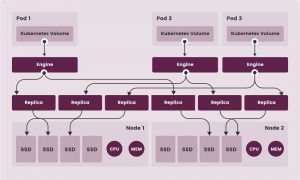Longhorn Extends Kubernetes-Native Storage Capabilities to Support Edge Deployments
Used with Rancher, allows DevOps teams to manage persistent data volumes from core to cloud to edge.
This is a Press Release edited by StorageNewsletter.com on February 4, 2021 at 2:06 pmSuse LLC, owner of the Rancher container management platform, celebrates the releaseed Longhorn 1.1.
How Longhorn works
Click to enlarge
Longhorn has been a Cloud Native Computing Foundation (CNCF) Sandbox project since October 2019. Since becoming generally available in June 2020, Longhorn adoption has increased by +235% to become a mainstay of the Kubernetes storage landscape. With this latest release, Rancher users can leverage a Kubernetes-native storage solution in low-powered hardware at the edge.
Longhorn 1.1 allows DevOps teams to easily manage persistent data volumes in any Kubernetes environment while bringing an enterprise-grade but vendor neutral approach to cloud-native storage. With this latest update, Rancher users can build additional resilience into their edge environments with ARM64 support, new self-healing capabilities, and increased performance visibility provided by Longhorn 1.1.
Gartner predicts that by 2025, 3/4 of enterprise-generated data will be created and processed at the edge outside a traditional centralized datacenter or cloud. That’s a sharp increase from just 10 percent in 2018. With this growth in mind, Longhorn 1.1 allows developers to confidently build applications and store data in edge environments on resource-constrained devices.
Click to enlarge
What’s new in Longhorn 1.1?
It is 100% open source, microservices-centric, and cloud-native storage for Kubernetes deployments.
Longhorn 1.1 brings features and improvements for enterprise DevOps teams, including:
-
Robust Kubernetes-native storage at edge
Longhorn 1.1 extends Kubernetes-native storage capabilities to support edge deployments. It’s designed to help teams store data reliably within even the most hostile and resource-constrained environments. It also comes with support for ARM64 one of the most requested features from the community. -
Driving efficient container performance
Improving efficiency is consistently top of mind for users in the K8s community. Likely to be a popular introduction, Longhorn now offers ‘ReadWriteMany’ support across containers, giving developers a persistent storage solution that enables volumes to be read and written across multiple containers at any time. Unlike ‘ReadWriteOnce’ methodologies, Longhorn 1.1 allows teams to share volume storage between different paths on different nodes. -
Enhanced visibility and operations support
Longhorn 1.1 brings better insights and functionality within an organization’s storage infrastructure. With new integrated support for Prometheus baked in, users now have real-time metrics of their storage health (monitoring, resource usage, tracking, etc.). With this support for Prometheus, users have a more detailed view of cluster performance. Finally, with new support for CSI Snapshotter, users can create/restore backups via ‘kubectl’. -
Boosted maintenance functionality
Another new arrival with Longhorn 1.1 is enhanced node maintenance capabilities. It supports Kubernetes drain operations to aid users with the safe performance of node maintenance. It also features the ability to recognize the existing disks on a new node, which provides a better operational environment for cloud providers. -
Increased resilience
Top of the priority list for most companies is mitigating network issues. A Data Locality feature has been introduced with Longhorn 1.1 to increase resilience in unstable network conditions (e.g., in edge scenarios). This new capability will keep a storage replica local to the workload itself, ensuring that, even if the node temporarily loses network connectivity, access to storage will never be lost.
Longhorn 1.1 is simpler than other SDS solutions aiming to deliver fast, reliable storage to most use cases without the bloat of legacy approaches.
Existing users of Rancher can install Longhorn directly from Rancher’s app catalog. Longhorn is also free to download and use, and customers looking for support can purchase a premium support model with the same SLAs provided through Suse Support Services. There are no licensing fees, and node-based subscription pricing keeps costs to a minimum.
Resources:
Persistent Storage, Built with CNCF Sandbox Project
Technical details about Longhorn 1.1
Rancher Academy: Interested in Rancher certifications?















 Subscribe to our free daily newsletter
Subscribe to our free daily newsletter

